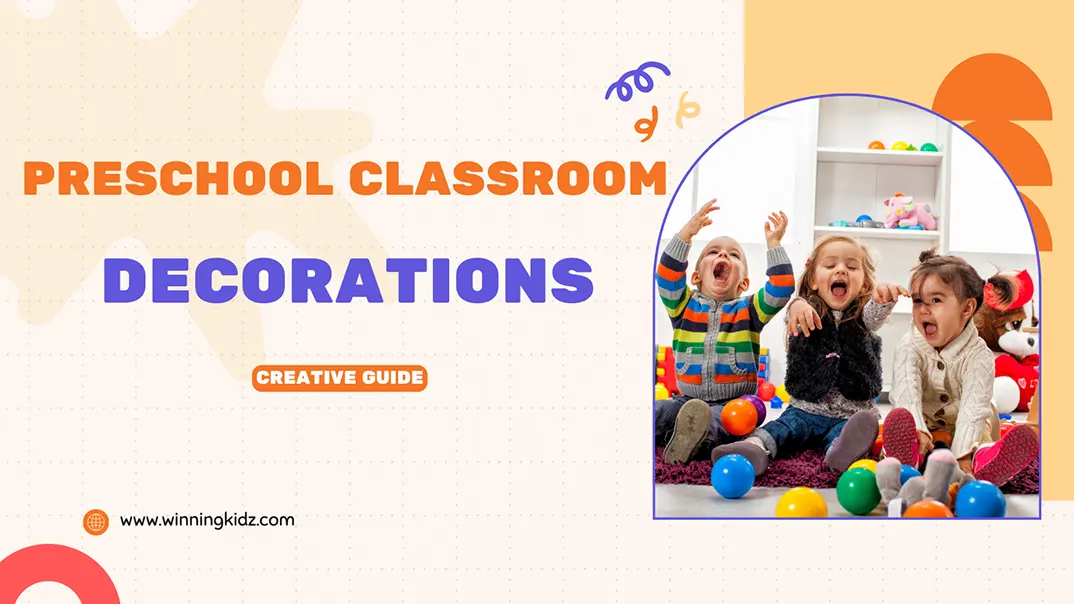Have you ever walked into a kindergarten and felt the warmth, creativity and inspiration? Do you want to know how to create your own creative kindergarten classroom? Do you know any wonderful preschool classroom decorations?
Designing preschool classroom decorations is all about finding the perfect balance. It’s about creating a space that sparks curiosity, inspires learning, and feels welcoming without overstimulating young minds. From selecting calming yet cheerful color palettes to adding playful, interactive elements, every decoration plays an important role in shaping a child’s daily learning experience.
In this guide, you’ll find practical ideas, color inspirations, and decoration themes tailored for preschool settings. From wall displays to reading corners, we’ll explore how every detail can support children’s learning and emotional well-being — without overwhelming your classroom.
Tại sao việc trang trí lớp học mầm non lại quan trọng?
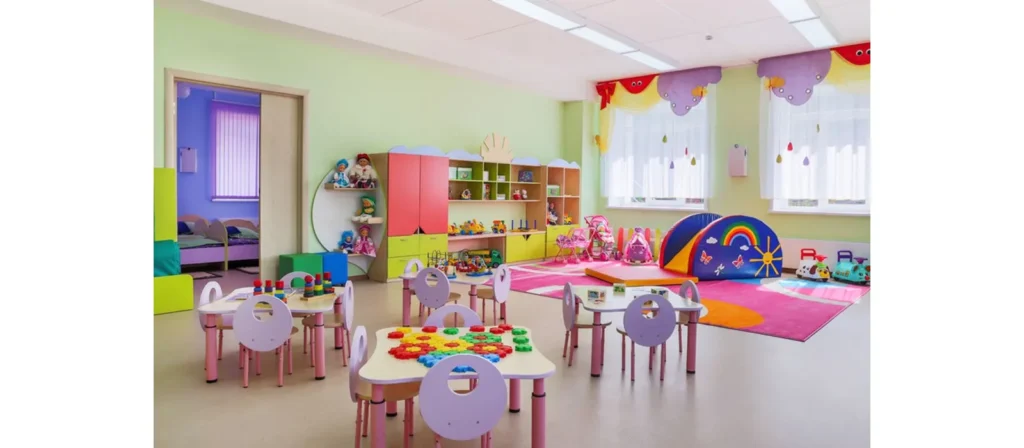
Tác động tâm lý của thiết kế lớp học
Research suggests that colors, spatial organization, and visual stimuli significantly impact children’s learning abilities and emotional well-being. Bright, warm colors can energize children, while soft pastels promote calmness and focus. Defined spaces within the classroom provide structure and help children transition smoothly between activities.
Khuyến khích học tập thông qua kích thích thị giác
Children in their early years learn best through sensory experiences. Thoughtfully designed preschool classroom decorations, including educational posters, themed displays, and hands-on interactive elements, help reinforce learning concepts and encourage exploration.
Thúc đẩy sự phát triển về mặt xã hội và tình cảm
A well-decorated classroom supports not just academics but also social and emotional development. Displays that celebrate student achievements, diversity, and teamwork foster a sense of pride and inclusivity among children.
15 Preschool Classroom Decoration Ideas
Below are the 15 core ideas with practical guidance. Some entries include short project plans, supply lists, or implementation steps. You don’t need to implement every idea at once; pick the ones that match your program’s goals, space, and children’s needs.
1. Create a Calming Environment
One of the first and most critical decorating decisions is setting the emotional tone of a classroom. Preschoolers thrive when the environment feels safe, predictable, and warm. Instead of overwhelming every wall with bold colors or every ceiling with dangling mobiles, aim for visual balance. Research indicates that classrooms with excessive visual stimulation can actually hinder attention and learning: in one study, children in heavily decorated rooms were off‑task significantly more than in sparsely decorated spaces.
- Choose a restrained palette. Pick two base tones and a bright accent used sparingly. For example: warm cream, sage green, and sunflower yellow accents. Use these across rugs, baskets, and bulletin borders.
- Designate quiet zones. Use a soft rug and low canopy to define a reading/calm area. Keep that area free from high‑contrast posters or flashing lights.
- Limit visual clutter. Opt for a few meaningful displays instead of covering every wall. Leave “negative space” — blank wall sections that reduce visual noise and let children rest their eyes.
- Lighting choices. Use diffused light — sheer curtains for windows and a soft lamp in the calm corner. Avoid direct harsh fluorescent lighting over the entire gathering area.
2. Decorate a Reading Area
A classroom without a dedicated reading space is like a library without shelves. Reading corners are not just functional—they’re emotional havens for preschoolers. A cozy, well-decorated reading area can promote literacy, build emotional security, and foster independent exploration.
Use soft seating like beanbags or small armchairs. Install low bookshelves so children can access books on their own. Then add thematic wall décor that matches current reading topics—jungle animals, fairy tales, outer space.
You can also include:
- Hanging mobiles with letters or characters
- Cushioned rugs with alphabet patterns
- Simple fabric canopies to create a “nook” feeling
If you have windows nearby, add light curtains to filter natural light and prevent distractions. The goal is to make this area inviting and slightly enclosed.
3. Decorate the Classroom with Kids’ Art
Displaying children’s creations increases motivation, builds identity, and makes the classroom feel like a shared community. It’s high‑impact, low‑cost décor that showcases learning processes, not just final products.
- Rotating gallery walls with framed student pieces
- A clothesline with clips to hang paintings
- Laminated drawings with each child’s name below
Make sure art is hung at the child’s eye level. You’re not just creating décor—you’re building self-esteem. It’s also a subtle classroom management tool. When children feel proud of their environment, they’re more likely to care for it.
4. Ideas for Bulletin Boards
Bulletin boards can be decorative, functional, and instructional all at once. They’re not just placeholders—they’re storytelling spaces. With thoughtful design, bulletin boards can support themes, showcase learning progress, and communicate important information.
- Monthly themes like seasons, community helpers, or holidays
- Student portfolios with writing samples or artwork
- Behavioral charts using positive reinforcement visuals
- Letter/Number of the week boards
Keep your boards interactive when possible. Add Velcro elements, flip panels, or spaces for student input. The more children can manipulate or engage with the board, the better.
Limit yourself to one or two major bulletin boards in the classroom, and keep the rest of the wall space calm and breathable.
5. Fun Birthday Displays
Celebrating birthdays in preschool is a great decorating opportunity. it builds community, acknowledges each child, and adds joy. But it’s important to balance fun with focus and inclusivity. But instead of generic, store-bought birthday posters, make your display personal and meaningful.
- A “birthday train” with each child’s photo in a train car
- A cupcake wall with children’s names and birthday dates
- A simple timeline with month headers and child-made icons
- Use a consistent format and color scheme to create continuity.
6. Design a Visual Schedule Board
Young children thrive on routine. When they can see what’s coming next, they feel more in control—and less anxious. A visual schedule board shows the daily routine in pictures and words. You can attach visuals with Velcro or magnets to move them around.
Images with short word labels are suitable for emerging readers and older children. Post the schedule near the door or gathering area for easy reference each morning. Choose a location near a transition (e.g., entryway, carpeted area) and at children’s eye level.
7. Decorate with a Welcome Banner
The first thing children see when they enter the classroom matters. A welcome banner can immediately establish a positive tone for the day.
Avoid overly flashy, generic “WELCOME!” signs. Instead:
- Use multi-language greetings to reflect classroom diversity
- Incorporate student photos or self-portraits
- Use themes like rainbows, trees, or sunshine to make it cheerful
You can involve children in making the banner. This increases their connection to the space and helps transition them into the learning environment from the very first step through the door.
8. Decorate the Classroom Door
The classroom door is an everyday canvas. Use it to reflect your classroom identity, themes, or even seasonal topics. With thoughtful decoration, it can become an extension of your classroom identity and a daily point of engagement.
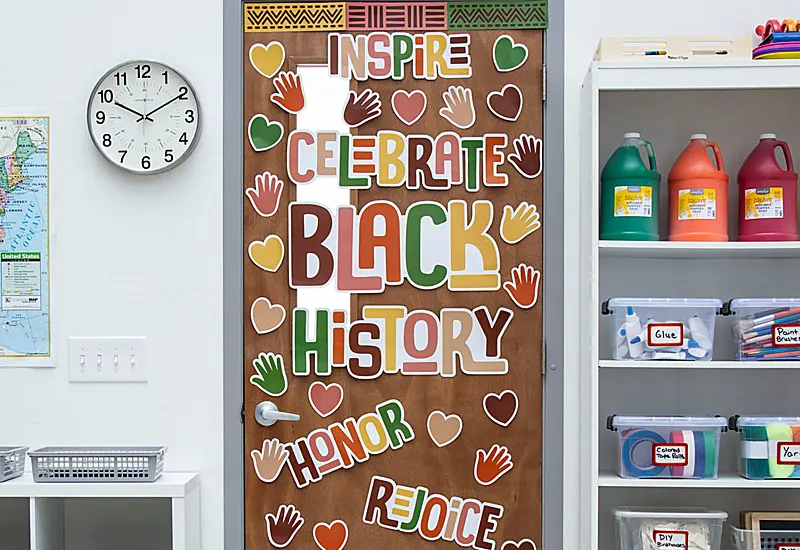
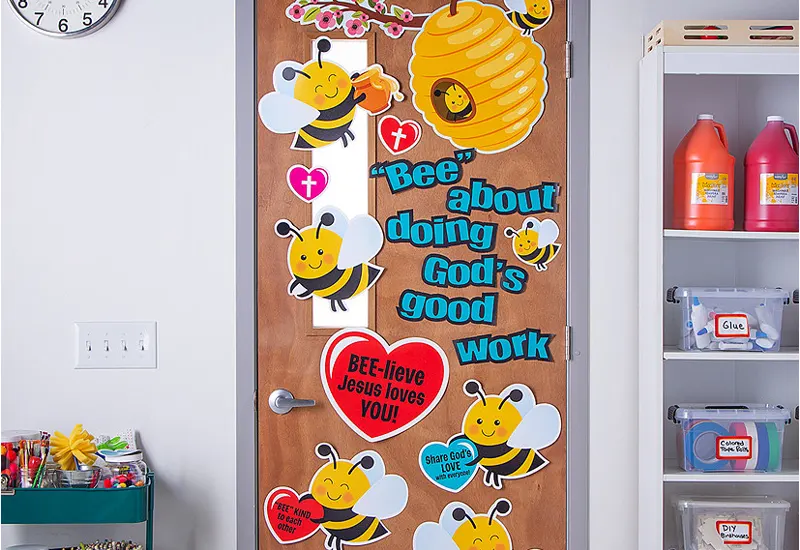
Ideas include:
- A “Who’s in Our Class?” door with children’s names and pictures
- A “Reading Adventure Starts Here” design for literacy-focused classrooms
- Seasonal or thematic displays like autumn leaves or space missions
9. Decorate the Windows and Ceiling
Many preschool teachers overlook the vertical space in the classroom. But the ceiling and windows are key visual elements in a child’s world. When decorated thoughtfully, they can bring warmth and depth to the classroom atmosphere.
Try these ideas:
- Paper lanterns or hanging pom-poms in thematic colors
- Mobiles representing seasons, numbers, or classroom mascots
- Window decals of animals, weather, or shapes
Be sure to balance visibility with safety. For windows, keep visibility clear at adult eye level but add designs at child height to make it engaging for them.
10. Use Rugs and Mats to Create Learning Areas
Floor decorations aren’t always visible. They’re also functional zones. Use rugs and mats to divide space and set behavioral expectations. Choose materials that are non-slip, easy to clean, and sized correctly for your classroom layout. Always opt for neutral or primary color schemes that match the overall classroom tone—not neon chaos.
11. DIY Wall Decor
DIY wall decorations are one of the most effective ways to bring personality and heart into your preschool classroom—without sacrificing budget or originality. Unlike store-bought posters that quickly become background noise, DIY décor invites participation, creativity, and connection.
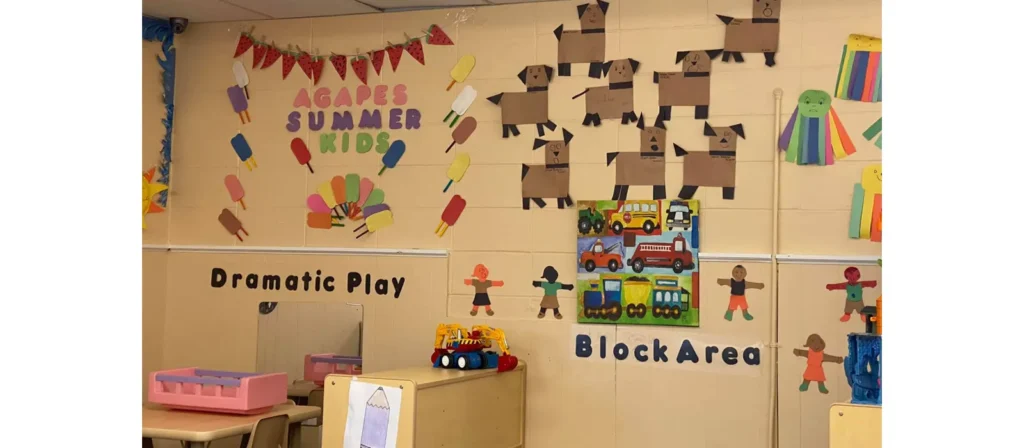
Here are DIY wall décor ideas:
- Create a “handprint tree” where each child adds their painted handprint as a leaf—then use it to track growth or seasons.
- Make a fabric or felt “learning journey” banner where children add personalized icons (e.g., “I learned to write my name,” “I counted to 20”).
- Use recycled magazine or paper scraps to create a colourful mosaic of shapes for a math wall.
- Use string and clothespins across a wall to display children’s current work.
- Have children help cut large letters or shapes for thematic walls and then allow them to place or arrange the pieces themselves.
- Laminate key visuals you use often so they last longer and can be reused year after year.
12. Creative Decorative Objects
While walls, boards, and rugs set the tone, the small decorative objects around your classroom are what give it warmth, depth, and storytelling. These elements should be intentional—not clutter—and always child-safe.
Classroom Mascots
Use a plush toy, puppet, or character figure as a “classroom mascot.” This character can sit on a shelf, participate in circle time, and even have its own name and backstory. It becomes a beloved member of the group and offers continuity.
Thematic Tabletop Displays
Create small decorative setups for the season or unit theme. For example:
- A basket of fall leaves, pinecones, and tiny pumpkins
- A globe, astronaut doll, and stars for space week
- Dinosaurs and faux fossils during a prehistoric unit
Keep these displays simple and child-accessible, using them to spark curiosity and discussion.
Repurposed Natural Materials
Use wooden bowls, stones, shells, or driftwood as both décor and manipulatives. They add texture and a sensory element to the environment, aligning well with Reggio and Montessori principles.
Family Photo Walls or Frames
A small corner with framed family photos helps create emotional security and connection. Each child can bring a family photo to display. This humanizes the room and helps children feel grounded.
Don’t overdo it—just a few key messages placed meaningfully can have a big impact.
13. Name Tags and Personalized Spaces
Personalization in the classroom helps each child feel valued and visible. At this developmental stage, children are forming a sense of identity, and seeing their name and picture on their cubby, seat, or project folder affirms their belonging in the classroom.
Name tags should be simple, clear, and easy to recognize. Ideally, they include the child’s name in large print alongside a visual cue, like a photo or a symbol. This helps children who are still developing literacy skills quickly locate their belongings. Teachers can even involve students in designing their own labels, giving them a sense of ownership and a creative opportunity to express themselves.
These personalized elements can extend beyond cubbies and tables. Mailboxes, supply bins, art drying racks, and classroom job charts can all be labeled with children’s names.
14. Music and Sound as Part of the Decor
While not visual, acoustic decorations can deeply influence the classroom atmosphere. Incorporating soft music, sound centers, or even musical instrument walls can enhance mood and support auditory learning.
Design ideas:
- A hanging bell wall where children can gently ring chimes
- A music corner with soft drums, maracas, or xylophones
- Background classical or nature soundtracks played during quiet time
Sound should be soothing, not overstimulating. Just like color and light, sound is an environmental tool that shapes behavior.
15. Reuse and Use Old Materials for Decorating
One of the most practical, sustainable, and creative decorating strategies is repurposing and reusing materials. This fosters resourcefulness, reduces cost, and often generates richer student‑centered décor.
Preschool decorating doesn’t need to strain your budget. Some of the most creative classroom spaces I’ve seen used entirely upcycled and repurposed materials.
- Turning old T-shirts into wall banners
- Using scrap fabric to create hanging flags
- Repurposing cardboard into student art canvases
- Framing sections of newspaper or old picture books
Những cân nhắc khi trang trí lớp học mầm non
Decorating a preschool classroom may seem like a simple task, but in reality, it requires thoughtful consideration, strategic planning, and a strong understanding of child development. An effective preschool classroom should be colorful and cheerful, yes—but also functional, safe, and developmentally appropriate. Every visual element you introduce into the space should serve a purpose: to support learning, reinforce routines, build a sense of community, or encourage independence.
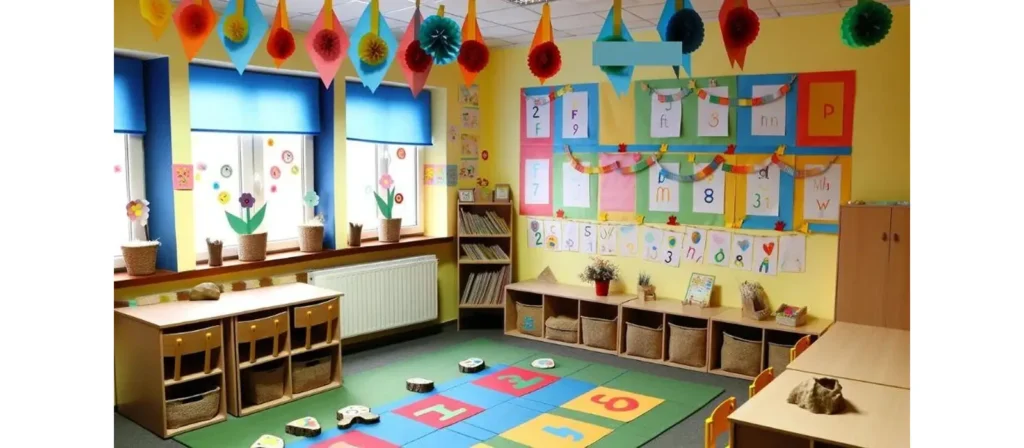
1. Use Bright Colors
Bright colors capture attention and create excitement. Young children are naturally drawn to vivid hues, and the right color palette can stimulate learning, reinforce themes, and differentiate classroom zones. However, the use of color should be intentional. Too much brightness everywhere can cause visual clutter and overstimulation.
2. Keep It at Eye Level
Since preschoolers spend most of their day sitting, playing, and walking close to the floor, decorations should be placed at their eye level. This helps children engage more meaningfully with visual aids, thematic displays, and instructional signage. It also fosters independence.
3. Keep Children Involved
When children help create or choose classroom decorations, they feel a sense of ownership and belonging. It fosters confidence and builds classroom community. Their contributions also reflect real learning and personal expression, making the décor more meaningful than store-bought posters.
4. Stay Organized
Young children rely heavily on structure. When decorations are messy or overdone, they blur those boundaries and confuse behavioral cues. Keeping things orderly doesn’t mean dull. It means that every visual element has a purpose, and everything has a place. Organized décor supports calmness, reduces conflict, and builds a productive learning environment where children feel secure.
5. Use Safe Materials
Safety should never be compromised in favor of aesthetics. All décor must be made from non-toxic, age-appropriate, and durable materials. Safety concerns include choking hazards, sharp edges, or flammable items. Ensuring all materials meet health and safety standards protects both children and staff, reducing risk during daily activities.
6. Keep Safety in Mind
Beyond material safety, decoration placement affects visibility, traffic flow, and emergency access. Hanging décor must be secure, exits must remain clear, and walkways must be free of tripping hazards. Designing with safety in mind prevents accidents and supports smooth classroom operations.
7. Choose the Right Furniture
Classroom decoration doesn’t start with posters and streamers—it starts with furniture. The layout, color, height, and placement of your tables, chairs, cubbies, and shelving units all play a role in how the classroom feels and functions.



- Select age‑appropriate furniture: Child‑sized tables, chairs, shelves at reachable heights.
- Consider flexible furniture: Pieces that can move easily or reconfigure support dynamic décor zones and seasonal changes.
- Furniture should serve dual purposes: For example, bookcases that display books cover‑out, or low cabinets with decorative tops to define zones and display children’s work.
- Matches the decor: Consistent finishes, clean lines, minimal patterns help décor and furniture feel unified.
- Durability and maintenance: Furniture for preschoolers must withstand active use, spills, and be easy to clean and rearrange.
Hãy gửi tin nhắn cho chúng tôi nếu bạn có bất kỳ câu hỏi nào hoặc yêu cầu báo giá. Các chuyên gia của chúng tôi sẽ trả lời bạn trong vòng 48 giờ và giúp bạn chọn đúng sản phẩm bạn muốn.
8. Remember to Change Your Decor
Children thrive on novelty and seasonal rhythms. Updating classroom decorations throughout the year keeps the environment stimulating and relevant. Whether it’s monthly bulletin boards, seasonal themes, or rotating student artwork, a changing environment supports curiosity and engagement. It also reinforces concepts like time, transitions, and cycles. However, changes should be predictable and structured—not random. A consistent update schedule helps children anticipate change and adjust comfortably. Planning décor updates alongside curriculum themes is the most effective approach.
9. Control Your Budget
A well-decorated classroom doesn’t have to break the bank. Reusing materials, incorporating student artwork, and DIY projects can achieve meaningful, personalized décor without excessive spending. Budget-friendly choices also model sustainability and creative problem-solving for children.
How to Decorate Spaces with Different Functions?
Một lớp học được tổ chức tốt phải có các khu vực được phân định rõ ràng cho các hoạt động khác nhau. Những không gian này giúp trẻ hiểu được nơi diễn ra các nhiệm vụ cụ thể và thúc đẩy quá trình chuyển đổi suôn sẻ hơn trong suốt cả ngày.
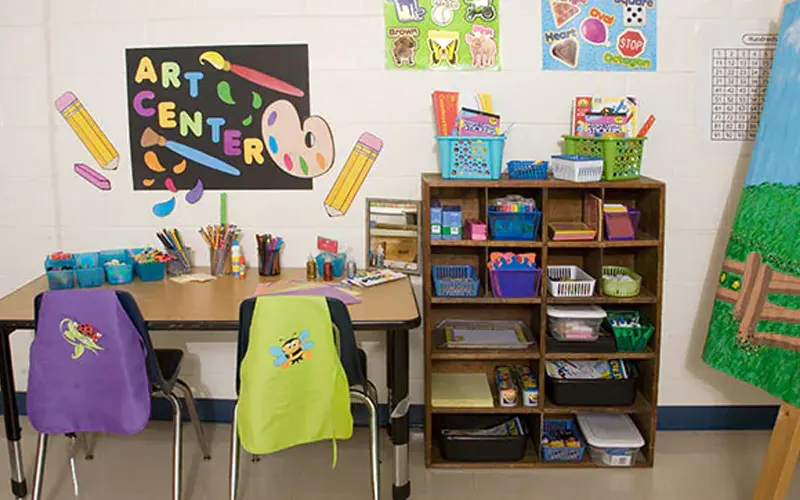
Trung tâm nghệ thuật mầm non
MỘT trung tâm nghệ thuật là vật dụng không thể thiếu để nuôi dưỡng sự sáng tạo và thể hiện bản thân. Chuẩn bị những vật liệu thân thiện với trẻ em như bút màu, sơn và đồ thủ công tái chế. Sử dụng giá treo tường nhiều màu sắc và giá phơi để trưng bày tác phẩm nghệ thuật của học sinh, giúp không gian vừa truyền cảm hứng vừa hữu ích.
Trung tâm khoa học mầm non
Một thực hành trung tâm khoa học khơi dậy sự tò mò và khám phá. Trang bị cho khu vực này kính lúp, thùng cảm giác và các thí nghiệm đơn giản. Các áp phích về thiên nhiên, hành tinh và cơ thể con người có thể đóng vai trò là đồ trang trí lớp học mầm non hấp dẫn, khuyến khích trí óc trẻ nhỏ đặt câu hỏi và khám phá.
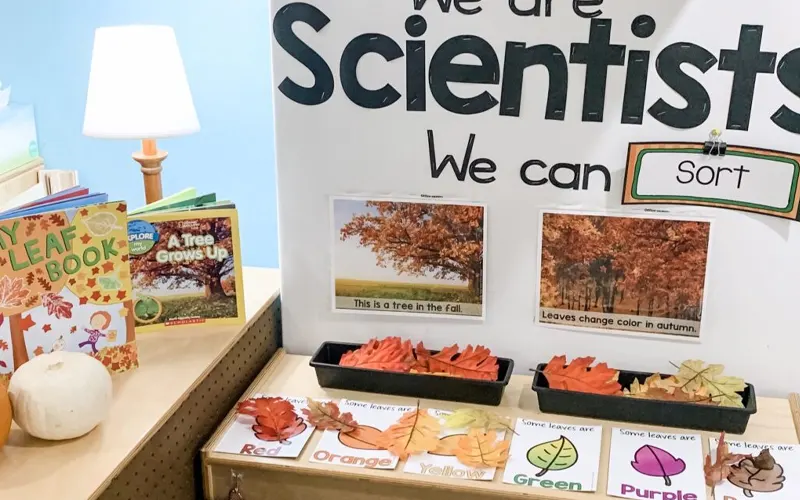
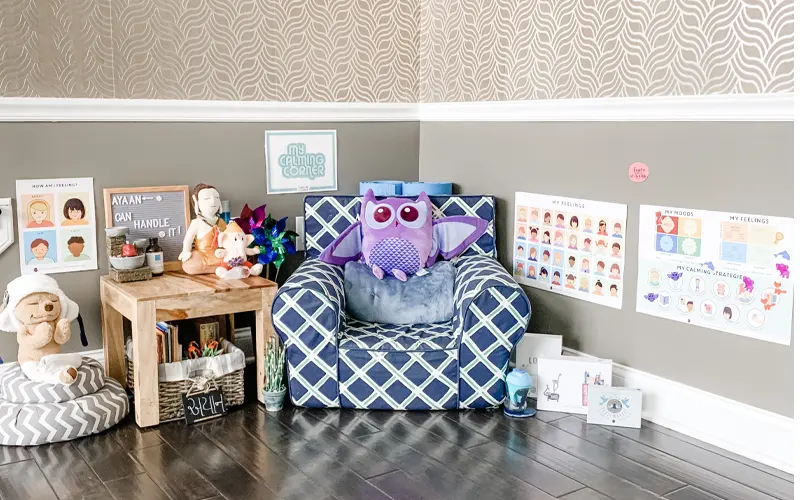
Góc bình tĩnh
MỘT góc bình tĩnh giúp trẻ tự điều chỉnh và quản lý cảm xúc. Sử dụng ghế ngồi mềm, màu sắc dịu nhẹ và các yếu tố cảm giác như đồ chơi fidget hoặc chăn có trọng lượng. Thêm đồ trang trí theo chủ đề thiên nhiên, chẳng hạn như mái che bầu trời đầy sao hoặc ánh sáng dịu nhẹ, có thể khiến không gian trở nên êm dịu hơn.
Góc đọc sách trong lớp học
Một góc đọc sách ấm cúng khuyến khích tình yêu sách. Sắp xếp các kệ sách có sách tranh dễ tiếp cận, thêm túi đậu hoặc đệm để tạo sự thoải mái và trang trí bằng áp phích bảng chữ cái hoặc đề can tường theo chủ đề kể chuyện để tạo ra một không gian văn học hấp dẫn.
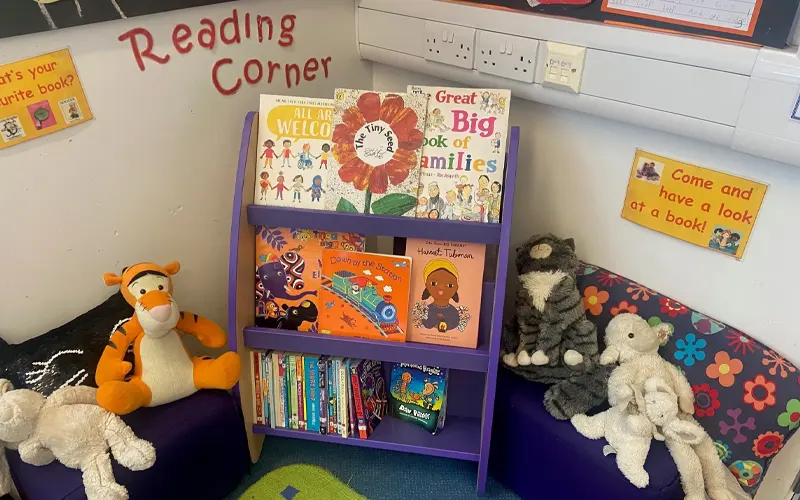
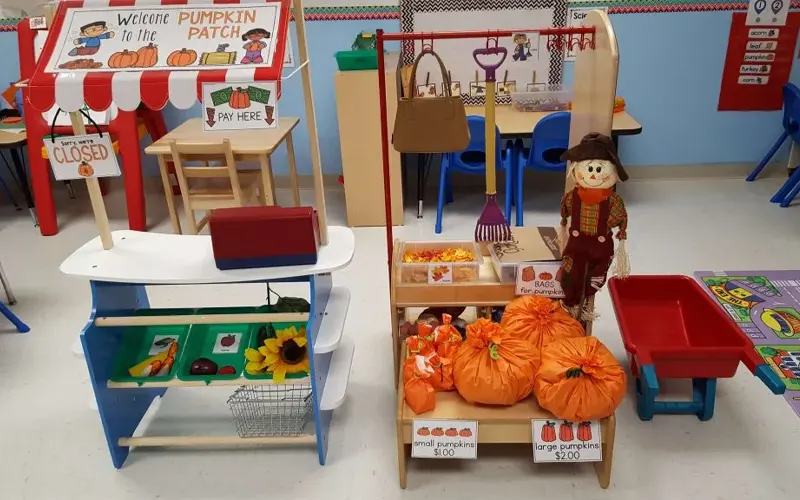
Khu vui chơi kịch tính
Vở kịch tăng cường kỹ năng xã hội và nhận thức. Cho dù đó là một nhà bếp giả, một siêu thị nhỏ hay phòng khám bác sĩ, đạo cụ và phông nền theo chủ đề có thể mang lại trò chơi tưởng tượng sống động. Thay đổi các thiết lập thường xuyên để giữ cho không gian hấp dẫn đối với trẻ em.
Trang trí lớp học mầm non theo mùa
Trang trí lớp học mầm non theo mùa giúp môi trường luôn tươi mới, hấp dẫn và mang tính giáo dục. Chủ đề theo mùa giúp trẻ kết nối với thiên nhiên, khám phá những thay đổi trong thế giới xung quanh và kỷ niệm những dịp đặc biệt. Cho dù đó là những bông hoa tươi tắn cho mùa xuân hay những bông tuyết ấm áp cho mùa đông, đồ trang trí lớp học mầm non theo mùa sẽ nâng cao bầu không khí học tập và biến lớp học thành nơi thú vị cho những người học trẻ.
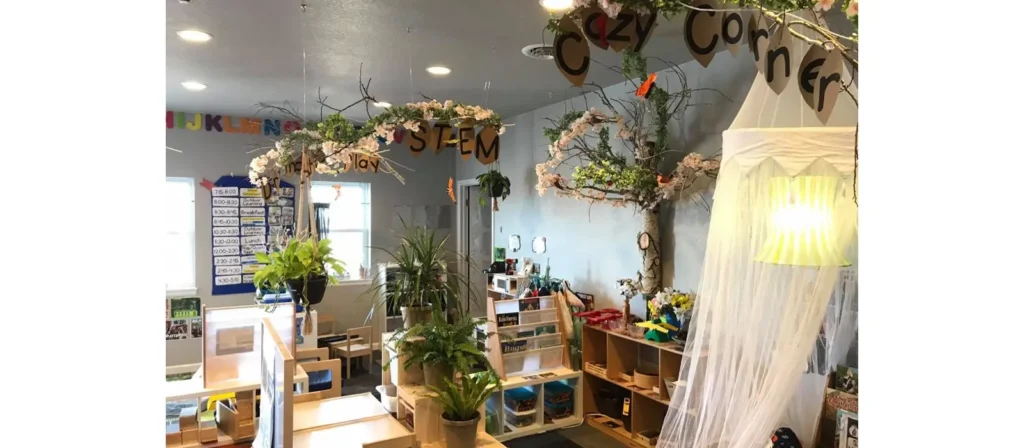
Trang trí lớp học mầm non mùa xuân
Mùa xuân là mùa của sự đổi mới, là thời điểm hoàn hảo để kết hợp các chủ đề trang trí lớp học mầm non tươi mới, đầy màu sắc và lấy cảm hứng từ thiên nhiên.
- Trang trí tường:Để tạo ra một bối cảnh sống động, hãy sử dụng đồ trang trí tường lớp học mầm non như hình cắt bướm, vòng hoa và băng rôn cầu vồng.
- Trang trí cửa lớp học:Cân nhắc các ý tưởng trang trí cửa lớp học cho trẻ mẫu giáo, chẳng hạn như cửa “Khu vườn phát triển” với hoa giấy và tên học sinh làm cánh hoa.
- Trang trí trần nhà: Treo đồ trang trí như đám mây giấy, giọt mưa và ánh nắng mặt trời có thể làm cho không gian trở nên nhẹ nhàng và thoáng mát.
- Góc hoạt động: Tạo một khu vực trồng cây nơi trẻ em có thể trồng các loại cây nhỏ hoặc thảo mộc, kết hợp ý tưởng trang trí lớp học cho trường mẫu giáo theo chủ đề về khu vườn.
- Trang trí có thể in:Sử dụng các vật liệu in để trang trí lớp học mầm non như áp phích bảng chữ cái theo chủ đề mùa xuân và biểu đồ học tập dựa trên thiên nhiên.
Trang trí lớp học mầm non mùa hè
Trang trí lớp học mùa hè nên phản ánh sự ấm áp, phiêu lưu và các hoạt động ngoài trời thú vị. Ý tưởng trang trí lớp học cho trẻ mẫu giáo vào mùa hè thường bao gồm chủ đề bãi biển, đại dương và cắm trại.
- Trang trí tường: Trưng bày sóng biển, cá và vỏ sò trên tường để trang trí cho lớp học mẫu giáo nhằm tạo ra thế giới dưới nước.
- Trang trí lớp học theo chủ đề: Sử dụng chủ đề lớp học mầm non đồ trang trí có bóng bãi biển, lâu đài cát và kính râm tạo nên bầu không khí vui tươi.
- Cửa sổ lớp học: Thêm hình dán mặt trời đầy màu sắc hoặc hình in dấu tay để làm bừng sáng cửa sổ trang trí lớp học mầm non.
- Trang trí DIY: Kết hợp trang trí lớp học mầm non tự làm bằng cách làm quạt giấy, diều và chong chóng.
Trang trí lớp học mẫu giáo mùa thu
Đồ trang trí mùa thu mang tông màu ấm áp, chủ đề thu hoạch và lễ kỷ niệm theo mùa. Đồ trang trí mùa thu cho lớp mẫu giáo thường tập trung vào bí ngô, lá cây và các sinh vật trong rừng.
- Tường & Bảng tin:Sử dụng ý tưởng trang trí tường lớp học cho trẻ mẫu giáo với lá rơi, bù nhìn và khung cảnh mùa thu ấm cúng.
- Cửa lớp học: Hãy sáng tạo với những ý tưởng trang trí cửa lớp học mùa thu cho trẻ mẫu giáo, chẳng hạn như “Vườn bí ngô” có tên của mỗi học sinh trên một quả bí ngô.
- Đồ trang trí treo:Trang trí trần lớp học mẫu giáo có thể có hình lá mùa thu, quả sồi và cú.
- Các yếu tố tương tác:Cây biết ơn nơi trẻ em ghi những lời cảm ơn là ý tưởng trang trí lớp học mầm non tuyệt vời.
Trang trí lớp học mẫu giáo mùa đông
Chủ đề mùa đông tạo nên một môi trường học tập ấm cúng và kỳ diệu với những bông tuyết, găng tay và đồ trang trí lễ hội. Đồ trang trí mùa đông cho lớp mẫu giáo mang lại sự phấn khích khi trẻ em tìm hiểu về thời tiết mùa đông và ngày lễ.
- Trang trí tường và cửa sổ:Sử dụng đồ trang trí mùa đông cho lớp học mẫu giáo như hình cắt bông tuyết, vòng hoa băng giá và động vật mùa đông.
- Cửa lớp học:Ý tưởng trang trí cửa lớp học mùa đông cho trẻ mẫu giáo bao gồm chủ đề “Xứ sở thần tiên mùa đông” với người tuyết và cảnh trượt tuyết.
- Trang trí trần nhà: Treo những bông tuyết bằng vải cotton hoặc đèn dịu nhẹ để tạo không khí lễ hội.
- Khu vực cảm giác: Thùng cảm giác theo chủ đề tuyết với tuyết giả và tượng động vật mùa đông làm nổi bật chủ đề trang trí lớp học cho trẻ mẫu giáo.
Trang trí lớp học mầm non ngày lễ
Đồ trang trí ngày lễ làm cho lớp học mầm non trở nên lễ hội và thú vị. Cho dù là lễ Halloween, Lễ Tạ ơn hay Giáng sinh, đồ trang trí lớp học mầm non giúp trẻ hiểu được các truyền thống văn hóa đồng thời tạo thêm sự ấm áp và vui nhộn cho không gian.
Trang trí lớp học Halloween cho trẻ mẫu giáo
Đồ trang trí Halloween mang lại sự ma quái vui tươi cho lớp học. Đồ trang trí Halloween cho lớp mẫu giáo phải vui nhộn và không quá đáng sợ.

- Trang trí tường:Sử dụng đồ trang trí lớp học cho trẻ mẫu giáo, như những chú ma thân thiện, bí ngô và dơi.
- Cửa lớp học: Ý tưởng trang trí cửa lớp học mẫu giáo có thể bao gồm chủ đề “Quái vật thân thiện” hoặc “Vườn bí ngô”.
- Trang trí tương tác:Bảng đếm “Trick-or-Treat” có thể là một phần trang trí trong lớp học mầm non đồng thời củng cố việc học.
- Đồ thủ công DIY: Khuyến khích trẻ em làm đèn lồng bí ngô và mạng nhện bằng giấy để trang trí lớp học.
Trang trí lớp học mầm non mừng lễ Tạ ơn
Trang trí Lễ Tạ ơn tập trung vào lòng biết ơn, thu hoạch và sự đoàn kết. Trang trí lớp học mầm non cho Lễ Tạ ơn có thể bao gồm các sắc thái ấm áp của mùa thu và các yếu tố chủ đề.
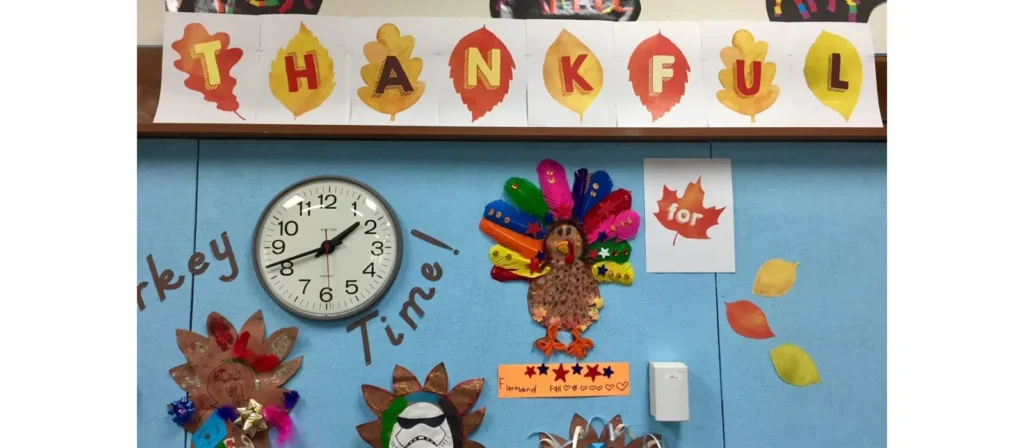
- Tường & Bảng tin: “Cây biết ơn” với những chiếc lá do học sinh làm thể hiện lòng biết ơn tạo nên vật trang trí tường hấp dẫn cho lớp học mầm non.
- Trang trí cửa lớp học: Trang trí cửa lớp học mẫu giáo như chú gà tây với dấu tay của học sinh làm lông vũ tạo thêm nét riêng tư.
- Trang trí bàn:Sử dụng đồ trang trí cho các thành phần của lớp học mầm non như bí ngô giấy, sừng dê và vòng hoa mùa thu.
Trang trí lớp học Giáng sinh cho trẻ mẫu giáo
Đồ trang trí Giáng sinh mang lại niềm vui và sự ấm áp cho môi trường mầm non. Đồ trang trí lớp học Giáng sinh ở trường mầm non có thể có màu sắc ngày lễ, nhân vật lễ hội và chủ đề mùa đông ấm áp.
Trang trí có thể in: Đồ trang trí lớp học mẫu giáo có thể in được, như biểu đồ bảng chữ cái theo chủ đề ngày lễ và áp phích số, mang đến nét học tập mang tính lễ hội.
Trang trí tường và trần nhà:Sử dụng đồ trang trí Giáng sinh, chẳng hạn như bông tuyết, cây thông Noel và đèn nhấp nháy, trong lớp học mẫu giáo.
Cửa lớp học:Ý tưởng trang trí cửa lớp học mẫu giáo bao gồm chủ đề “Xưởng của ông già Noel” hoặc “Ngôi nhà bánh gừng”.
Góc thủ công Giáng sinh:Ý tưởng trang trí lớp học Giáng sinh cho trường mầm non có thể bao gồm một trạm làm đồ trang trí tự làm.
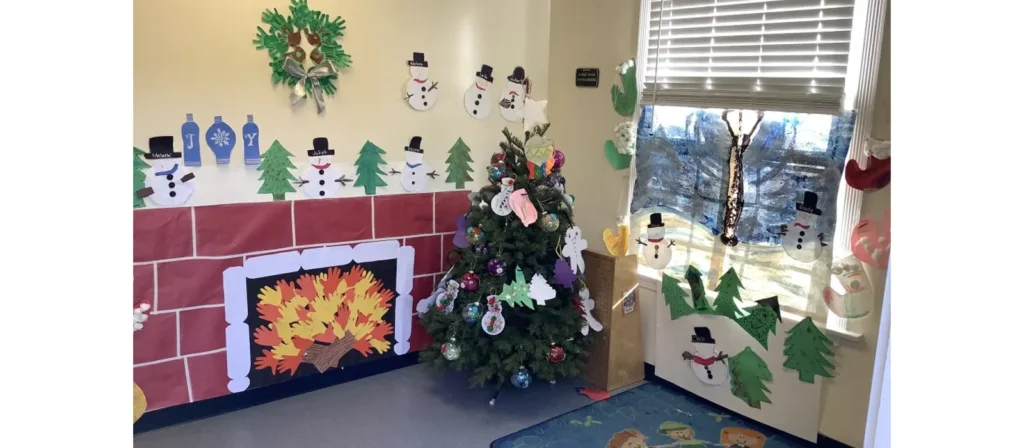
Phần kết luận
Trang trí lớp học mầm non đóng vai trò quan trọng trong việc định hình trải nghiệm học tập cho trẻ nhỏ. Một lớp học được trang trí đẹp mắt sẽ kích thích thị giác, khuyến khích tương tác và nuôi dưỡng sự sáng tạo. Bằng cách lựa chọn chủ đề cẩn thận, sử dụng các yếu tố tương tác và kết hợp đồ trang trí theo mùa và ngày lễ, các nhà giáo dục có thể tạo ra một môi trường học tập năng động và hấp dẫn.
Từ bảng thông báo tương tác đến đồ trang trí lấy cảm hứng từ thiên nhiên, mọi yếu tố của lớp học đều phải hỗ trợ việc học tập trong khi vẫn tạo nên không gian chào đón và thú vị. Đồ trang trí phải vừa có chức năng vừa vui nhộn, đảm bảo trẻ em cảm thấy hứng khởi mỗi ngày khi bước vào lớp học mẫu giáo.
Bằng cách liên tục làm mới môi trường học tập, giáo viên có thể giúp học sinh tập trung và hứng thú với việc học, tạo nền tảng cho sự tò mò và sáng tạo suốt đời.

